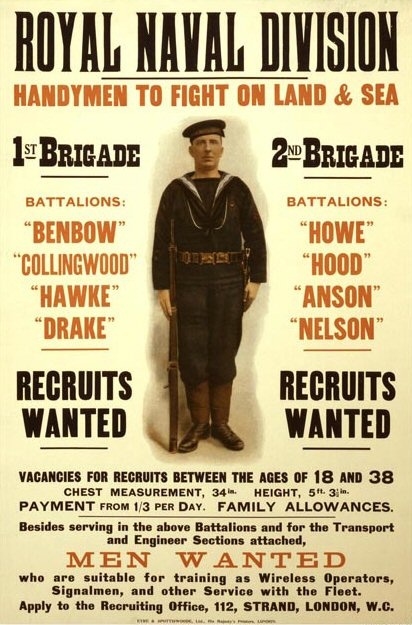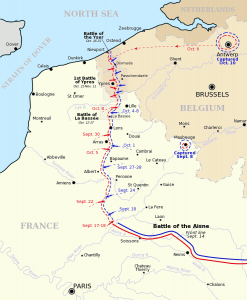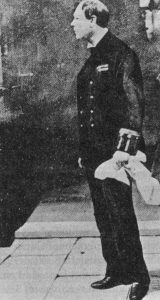
Finest Hour 177
Winston’s Dunkirk Circus

Recruiting poster for the Royal Naval Division
December 16, 2017
Finest Hour 177, Summer 2017
Page 20
By Barry Gough
On 7 August 1914, under safe cover of British cruisers and naval aircraft, the Admiralty set about the massive task of transporting the British Expeditionary Force across the English Channel to France. Between then and 27 August, the Royal Navy, without the loss of a man or damage to the ships, safely deployed 120,000 men plus supplies, transport, weapons, munitions, and other equipment across the Channel. It had been a wonderful operation on a scale previously undreamed of, and it had been conducted in such secrecy that the German Supreme Command confidently told its mobile army headquarters in Belgium that no landing of British troops on a large scale had yet taken place. This was on the eve of the first British shot on the continent, near Mons, on 22 August. Admiral Lord Fisher, the onceand-future First Sea Lord, liked to say that the Army was a projectile to be fired by the Navy. Here lay proof of that.
The BEF commenced its concentration, taking up its intended position on the north and west flank of the French army. The German army’s push to defeat the French army was halted at the Battle of the Marne. In a whirl of movements, the front shifted north and into Belgium, leaving exposed the hugely important Channel ports. If Germany could get possession of Antwerp, it would gain immeasurable power in waters opposite the River Thames. German staff knew that Antwerp must be taken to safeguard the right rear of their armies swinging down into France. As First Lord of the Admiralty, Churchill signalled Admiral Sir John Jellicoe, commanding the Grand Fleet, to contemplate the proper positioning of his ships if the Germans were to take measures to control the Channel coast.
Churchill’s Vision
Churchill grasped the realities of the German sweep towards the Belgian frontier. He had true instincts for making war, and the instincts for taking the initiative. He had his pet schemes, and the Admiralty gave him almost unlimited scope to carry them out. On 2 August, the Admiralty authorized the formation of the “Flying Column” Royal Marines, from which developed the Royal Marines Brigade, something of a private army for Churchill. He also had his own air wing, the Royal Naval Air Service (RNAS), and he could do very much as he liked with these resources.

2024 International Churchill Conference
At the outset of the war Churchill had established a naval air station at Ostend, where he deployed airplanes and an airship. This was seen as critical in matters of surveillance and communications, as it was designed to keep a watch out for any German naval movements, including submarines, and to give early warning. Under the direction of Commander C. R. Samson, airplanes made reconnaissance flights daily over the area between Bruges, Ghent, and Ypres. On the ground, using two cars, one of them fitted with a Maxim gun, Samson made a reconnaissance as far as Bruges. Churchill considered it essential to deny Zeppelins the use of space within a hundred miles of Dunkirk. Churchill’s obligations were widening quickly. On 3 September, Secretary of State for War Lord Kitchener asked Churchill to take responsibility for the aerial defence of the United Kingdom. Churchill agreed, and so was in charge of all Royal Flying Corps aircraft engaged in the defence of the home islands, plus searchlights and anti-aircraft guns, as well as the RNAS.
Churchill was the apostle of the offensive and soon began considering landing forces on other coasts. Within a week, he was advocating formation of a naval brigade, using naval reservists, which would be built around the existing Marine brigade and under Admiralty control. It would serve alongside the Army, occupying advanced naval bases. At this early stage, the best Churchill could get from the Board of Admiralty was approval for a naval demonstration in an effort to distract the Germans: the Marine Brigade was landed at the port of Ostend on 26 August, where it stayed for a week. This was half a loaf. A modified form of Churchill’s plan was later carried out, but it was on too small a scale to have any dramatic effect on German movements. This episode showed how Churchill “could overrule his naval experts, that he hungered for action, and that he ignored naval advice.”1 All the plans, schemes, and rules for the conduct of war that had been worked out for years at the Naval War College in Greenwich and at Portsmouth, and of limited, combined, and amphibious warfare, were now dead. Political expediency had supplanted sound military thought and practice. Politics deflected strategy. Churchill proceeded with his designs.
The Royal Naval Division
On 7 September The Times announced formation of a force of 15,000 men called the Naval Brigades. These grew into the Royal Naval Division, consisting of the 1st Brigade (Battalions: Benbow, Collingwood, Hawke, and Drake) and 2nd Brigade (Battalions: Howe, Hood, Anson, and Nelson). “Mr. Churchill, with characteristic genius and energy, has decided to take advantage of this patriotic feeling [of young men wanting to join the Navy]…the nucleus of which will be found in existing reserves for the naval services which cannot be given employment afloat at present.”2 The Royal Marines, which had been at Ostend, formed a third brigade.
Lord Fisher, then living in Richmond, Surrey, was drawn into the scheme. On 6 September he wrote to his son to say that Churchill had called him: “Winston Churchill got me on the phone this morning and wants me to be the head of something—some sort of Naval Brigade, I think…but the telephone not very clear. He said he had written, but I had never got the letter. Probably some German spy postman has sent it to Berlin!”3 A lunch at the Admiralty was set for discussion of it with Churchill. Fisher was made the honorary colonel of the 1st Royal Naval Brigade.
The formation of the Naval Brigades came as a stopgap, for the BEF did not have the force in strength that had been anticipated (two divisions were held back in England for territorial defence). Four divisions of infantry plus the cavalry division were despatched to the Continent. Churchill’s argument was that if the sailors were not needed at sea, they could be employed with effect on land. With haste they were gathered together and trained as best they could be, but it is generally agreed that they were poorly trained and ill-equipped. Churchill had asked Kitchener for artillery and had even suggested that units in India be brought home to support the Naval Division. Kitchener replied that he had no officers or guns to spare. It was said at the time that these new and largely untrained units would not be used on the continent until the naval situation was entirely favourable to the Allies. As the days of August advanced, however, and as German successes became manifest, it was clear the Naval Brigades would soon be deployed.
The Western Front
Our story now shifts to the left flank of the Allied armies and to the double and interlocking story of “the Dunkirk circus” (or as Churchill renamed it “the Dunkirk guerrilla”) and origins of Churchill’s Antwerp adventure—the whole forming a chapter in British military operations that has always been on the margins of history. Official histories spurn it. It is an episode in which Churchill played a conspicuous part. As events proved, it did him little credit, engulfed as he was in the tumultuous events of those early months of the war. Fisher later wrote that the BEF ought to have gone to Antwerp rather than to the Ypres salient, and he may have been right. But in the circumstances of the unfolding war, the requirement to come to France’s immediate aid did not allow for a Belgium operation, and so the die was cast.

On 16 September, Kitchener received a telegram from General Joffre of the French high command asking for reinforcements to be sent to Dunkirk to confuse the Germans as to the strength of the defences and threaten their lines of communication. Churchill later maintained that the Dunkirk Circus did not originate with him but was the result of other factors. This is correct: Kitchener consulted Churchill. What was needed, besides reinforcing the Dunkirk garrison, were mobile forces that could display power by mobile arrangements and create diversions. Churchill sent the Royal Marines Brigade and insisted that a force of Yeomanry also be sent. Thus it was that the Oxfordshire Hussars, mobilized on 4 August and in which his brother Jack Churchill was a major, came to be part of the operation. A charming sidelight on the Churchills’ own regiment was recounted by General J. F. C. Fuller, the noted historian of war:
I remember when the Oxford Hussars embarked, they brought with them a vast quantity of kit: tin uniform boxes, suitcases and cabin trunks, as if they were on their way round the world. Someone questioned the loading of this baggage, whereupon a red-faced Major burst into my office in a towering rage: “This is simply damnable!” he shouted. “Winston said we could take ’em, and now one of your prize B. F.s says we can’t….” “All right! All right!” I cut him short. “What is the trouble about?” And having ascertained what the First Lord of the Admiralty had sanctioned, I telephoned down to the A. E. S. O. in charge to load the officers’ trousseaux—a word which did not seem to please my furious friend. All were loaded, and, I believe, a week later were unpacked by German hands.4

It was also arranged that fifty London motorbuses would be sent with them to make the sailor-soldiers as mobile and conspicuous as possible as they rumbled through Ypres, Lille, Tournai, and Douai. The whole business constituted a demonstration, or a feint, designed to give an ostentatious display of a British Army arriving and thereby warding off a German approach to Belgium and the adjacent French coast. Using air reconnaissance and cover, and employing mobile squads, the intention was to give an appearance of something greater than it actually was. Churchill could supply the naval air as required. The Royal Marines were disembarked at Dunkirk on the night of 19 and 20 September. They gave aid to the RNAS unit that had a squad of fifty armoured Rolls-Royce motorcars. These mounted Vickers machine guns, and some of them carried mounted armoured plate slung in such a way that they could bridge cuts in the road deliberately excavated by German units. (A hint of the development of the tank shows itself here.) Jack’s squadron of Oxfordshire Hussars acted as an escort to the naval air squadron commanded by Captain C. R. Samson. The ranging sorties of these cars with armour plating discomfited the Germans, causing them to withdraw, but at the same time attracted the attention of the German higher command. Three squadrons of RNAS bombarded German defences from bases in northern France. And from its base at Dunkirk, the naval air wing soon began to take the war to the enemy’s air power. Twelve aircraft stationed at Dunkirk flew missions of destruction against Zeppelin bases, and put advance German air bases and refuelling depots being constructed in Belgium out of commission.
Winston Takes Command
Churchill took an active part in directing these operations, crossing the Channel frequently in the cruiser Adventurer to confirm the force’s needs were adequately provided for, and at one stage intervening to make sure that heavy lorries and additional buses were sent. It was a successful operation, but the Royal Marines were withdrawn three days later, and were embarked in the 7th Battlecruiser Squadron, the same units that had ferried them across the Channel. Worries that the cruisers posed too tempting a target brought the amphibious operation to an end. From this early episode we find the genesis and evolution of “the Dunkirk circus”—with Churchill at the centre of operations and decision-making.
Asquith, said his daughter Violet, referred to Churchill’s Dunkirk force as “his own little army,” which is true.5 It was rather clear to his critics (sitting more comfortably in London) that he was engaging in what might be called “Winston’s little war,” and he waged it with intensity and imagination. While many of his cabinet colleagues recoiled at thoughts of a continental war and others sought alliances to serve the interests of the nation, Churchill plunged right in and proceeded to act strongly and independently, a tendency supported by his powerful office at the Admiralty. The Battle of the Marne checked the German race to the sea and took the pressure off Dunkirk, but now the worrying scene shifted north along the coast towards Antwerp. Napoleon had seen this Belgian city as “a pistol pointed at the heart of England,” and Churchill, fully conversant with Napoleon’s thinking on these matters, realized that the coast and the Channel ports in enemy hands would threaten the security of the British Isles. From the British perspective, precious Antwerp had to be held. At the outset of the war he had pressed on his cabinet colleagues the necessity of guarding against German domination there; however, no independent action was possible, as there still was no Allied military strategy in this regards. Meanwhile events were unrolling rapidly. With Kitchener’s nominal support, Churchill’s immediate scheme was to keep the Channel ports in Allied hands. He did great good for this cause and largely succeeded. All the same, the war widened towards vital Antwerp, where Winston played a significant and theatrical role in military and political leadership in a rapidly deteriorating situation against impossible odds of overwhelming enemy numbers and devastating heavy artillery—another story of “Winston’s War” for another time and place.
Barry Gough is a member of the International Churchill Society’s Board of Academic Advisers. This chapter is adapted from his forthcoming book Churchill and Fisher: Titans at the Admiralty.
Endnotes
1. Donald M. Schurman, Julian S. Corbett, 1854–1922: Historian of British Maritime Policy from Drake to Jellicoe (London: Royal Historical Society, 1981), p. 158.
2. “Naval Brigade,” The Times, 7 September 1914.
3. Arthur J. Marder, ed., Fear God and Dread Nought: The Correspondence of Admiral of the Fleet Lord Fisher of Kilverstone, vol. III, Restoration, Abdication, and Last Years, 1914–1920 (London: Jonathan Cape, 1959), p. 57.
4. Max Hastings, ed., Oxford Book of Military Anecdotes (Oxford: Oxford University Press, 1985), pp. 328–29.
5. Violet Bonham Carter, Winston Churchill as I Knew Him (London: Eyre and Spottiswoode and Collins, 1965), p. 329.
Subscribe
WANT MORE?
Get the Churchill Bulletin delivered to your inbox once a month.


